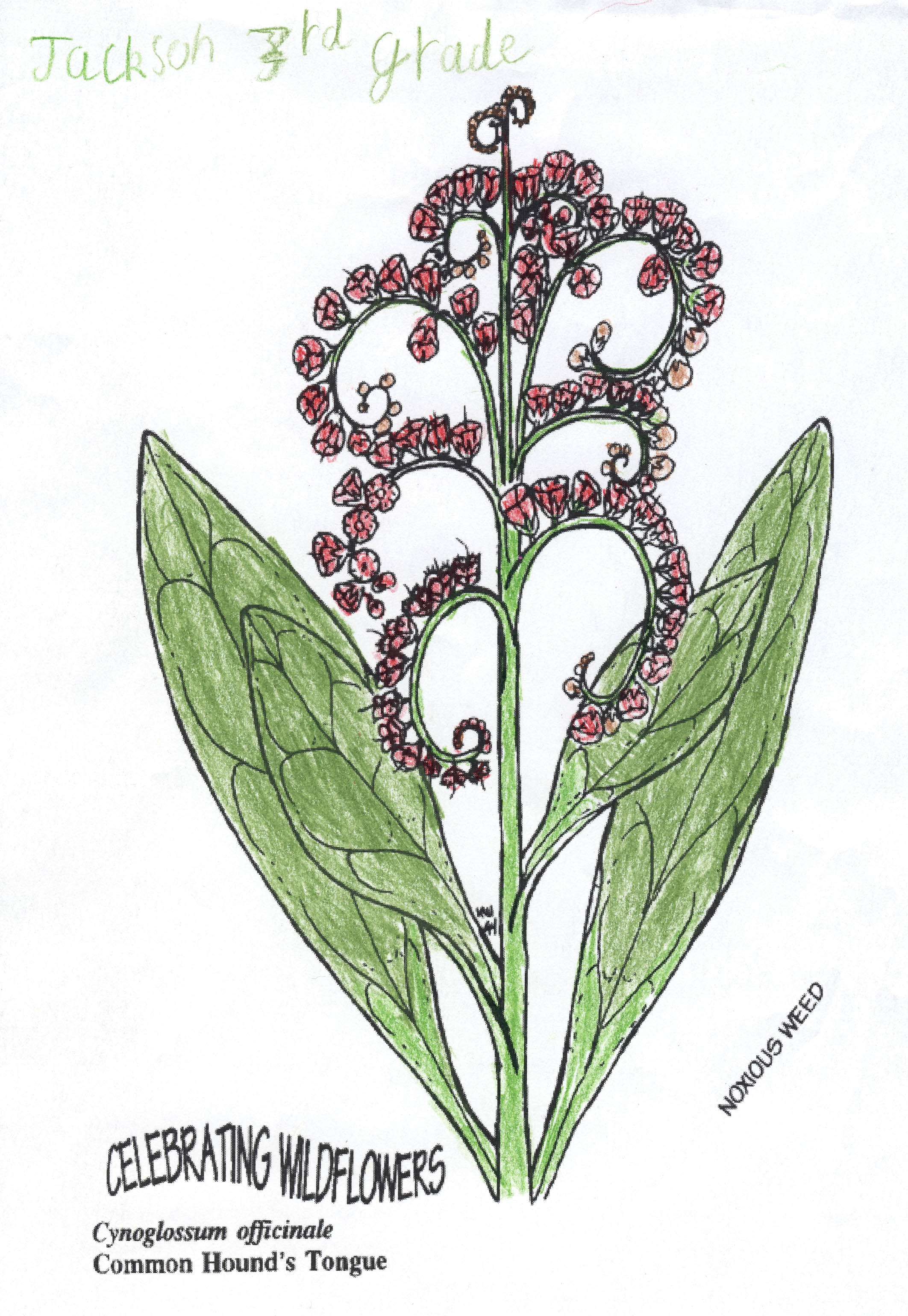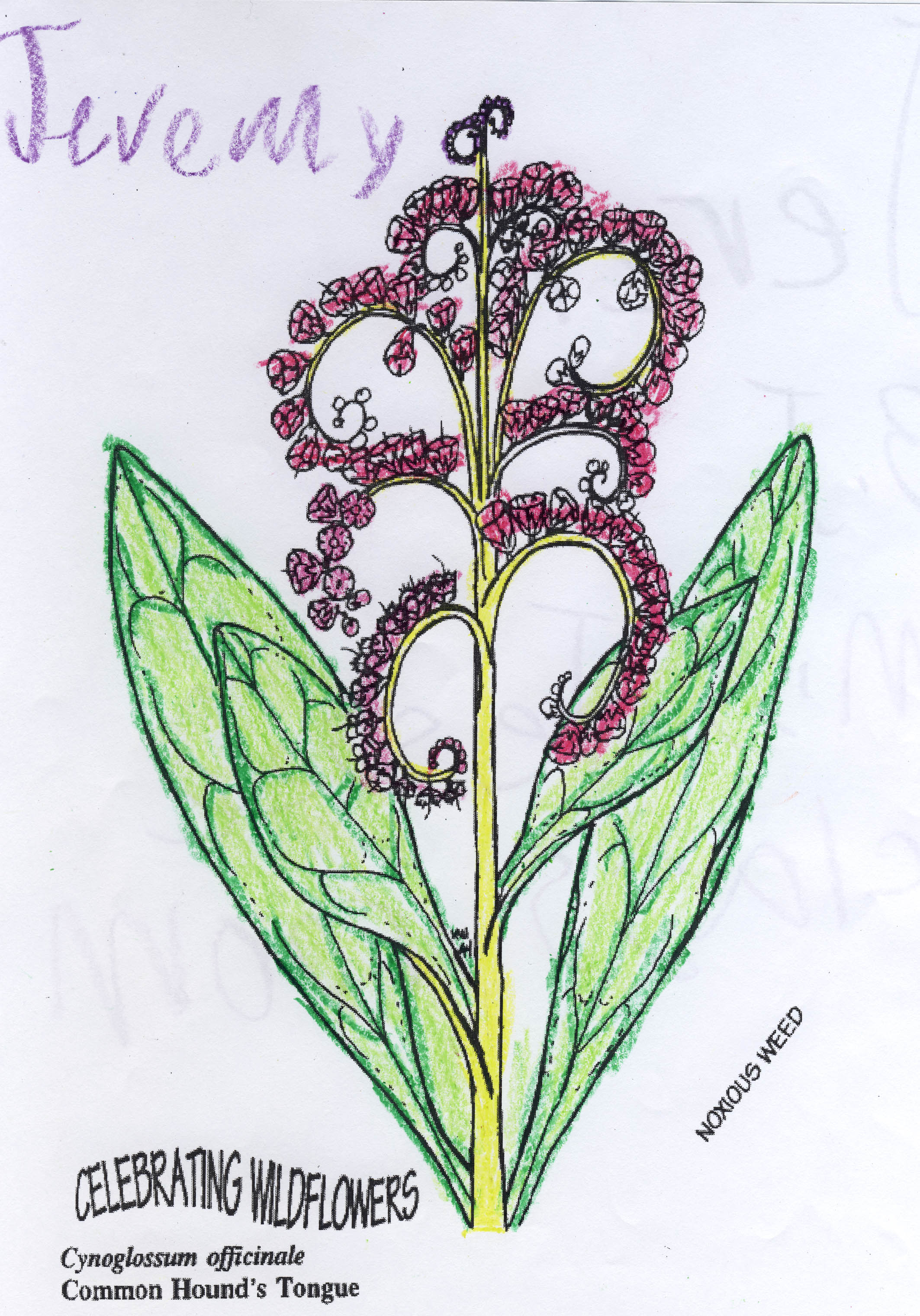Houndstongue
Outline
I. Description
A. Non-native biennial (two year life cycle)
B. Grows 1 1/2 to 3 feet tall.
C. Forms a rosette
1. Leaves near ground in circle with no visible stem.
2. Leaves grow to about 4 to 12 inches long.
3. Leaves are hairy and rough and feel like a dogs tongue, that's where it got its name.
D. Flowers are reddish purple.
1. They are terminal (which means they grow at the end of the stem).
E. Seed Pods
1. They are distinctive 1/3 of an inch across.
2. Covered with barbs that enable them to stick to hairs.
F. Grows in many places.
1. Pastures, road-sides, fields, and ranges.
II. Toxic Principle
A. Contains pyrrolizidine alkaloids.
1. Horses and cattle are susceptible to poisoning from alkaloids.
2. Sheep are tolerant of the alkaloids.
B. Alkaloids
1. Have a cumulative effect on the liver.
2. Will induce fatal poisoning once 5-10% of animals body weight has been consumed of the plant.
C. Death From Houndstongue
1. Due to severs liver failure.
III. Symptoms
A. Weight loss, rough hair coat, depression, and diarrhea.
IV. Livestock Management
A. Put livestock in a dark stall to keep them out of the light.
B. Feed high energy food.
1. Avoid grazing treated areas until plants have died.
V. Plant Management
A. Don't over graze.
1. That's when houndstongue takes over.
B. Keep Irrigating Your Field
1. Keeps lots of healthy grasses/forbs
C. Mow Your Field
1. Puts stress on the Houndstongue seeds.
2. Drastically reduces the seed production by 60%
3. Mow before houndstongue has bloomed.
VI. Mechanical Control
A. Spread by sticking to other animals.
B. To brake cycle
1. Remove plant at flowering or early seed formation.
2. Pull or dig weeds out.
3. Bag and destroy the plants so seeds do not mature after you pull it.
VII. Chemical Control
A. Spray Houndstongue with herbicides.



mtwow.org HOME - Back to Student Artwork Page
A. Non-native biennial (two year life cycle)
B. Grows 1 1/2 to 3 feet tall.
C. Forms a rosette
1. Leaves near ground in circle with no visible stem.
2. Leaves grow to about 4 to 12 inches long.
3. Leaves are hairy and rough and feel like a dogs tongue, that's where it got its name.
D. Flowers are reddish purple.
1. They are terminal (which means they grow at the end of the stem).
E. Seed Pods
1. They are distinctive 1/3 of an inch across.
2. Covered with barbs that enable them to stick to hairs.
F. Grows in many places.
1. Pastures, road-sides, fields, and ranges.
II. Toxic Principle
A. Contains pyrrolizidine alkaloids.
1. Horses and cattle are susceptible to poisoning from alkaloids.
2. Sheep are tolerant of the alkaloids.
B. Alkaloids
1. Have a cumulative effect on the liver.
2. Will induce fatal poisoning once 5-10% of animals body weight has been consumed of the plant.
C. Death From Houndstongue
1. Due to severs liver failure.
III. Symptoms
A. Weight loss, rough hair coat, depression, and diarrhea.
IV. Livestock Management
A. Put livestock in a dark stall to keep them out of the light.
B. Feed high energy food.
1. Avoid grazing treated areas until plants have died.
V. Plant Management
A. Don't over graze.
1. That's when houndstongue takes over.
B. Keep Irrigating Your Field
1. Keeps lots of healthy grasses/forbs
C. Mow Your Field
1. Puts stress on the Houndstongue seeds.
2. Drastically reduces the seed production by 60%
3. Mow before houndstongue has bloomed.
VI. Mechanical Control
A. Spread by sticking to other animals.
B. To brake cycle
1. Remove plant at flowering or early seed formation.
2. Pull or dig weeds out.
3. Bag and destroy the plants so seeds do not mature after you pull it.
VII. Chemical Control
A. Spray Houndstongue with herbicides.
We
had the students in Mrs. Jessee's class color a picture in of
Houndstongue that we gave them. We told them that they had to color the
best they could, because the three best pictures that were colored
would be put onto the internet! The winners of the coloring contest
are: Jackson, Jeremy, and Dawson!



mtwow.org HOME - Back to Student Artwork Page